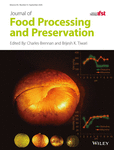Effects of water addition and noodle thickness on the surface tackiness of frozen cooked noodles
Abstract
The effects of water addition and noodle thickness on the surface tackiness of frozen cooked noodles (FCNs) were investigated. The results showed that the FCNs with water addition of 34% had high disulfide group content and small ice crystal in the freezing process, which was a benefit for forming a stable gluten network. The texture characteristics (hardness, chewiness, and tensile strength) were at the best level and the surface tackiness exhibited the lowest level. Besides, the low moisture area in the recooked FCNs increased with the ascent of noodle thickness and the hardness of thick FCNs was high for forming reliable spatial support. The texture characteristics of recooked FCNs (thickness 2 mm) were better. Combined with the sensory evaluation, when the water addition was 34% and the thickness was 2 mm, the surface tackiness of recooked FCNs was lower, and the FCNs had a good quality and taste.
Practical applications
In this study, the effects of water addition and noodle thickness on the surface tackiness of frozen cooked noodles (FCNs) were investigated. When the water addition (34%) and noodle thickness (2 mm) were at the appropriate level, the surface tackiness of recooked FCNs was low, and the FCNs had a good taste and appearance. The texture properties and sensory evaluation of the FCNs were the best. The study provides a reference for processing the FCNs with low surface tackiness in the fast-food industry. At present, the FCNs made according to this research results are widely used in the Chinese mainland market. The water addition of FCNs is 34%~36%, and the shape of FCNs is basically 20 cm length, 3 mm width, and 2 mm thickness.
CONFLICTS OF INTEREST
The authors have declared no conflicts of interest for this article.




